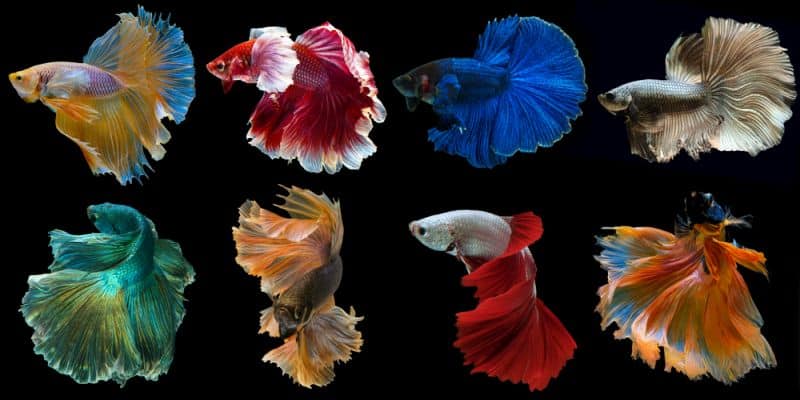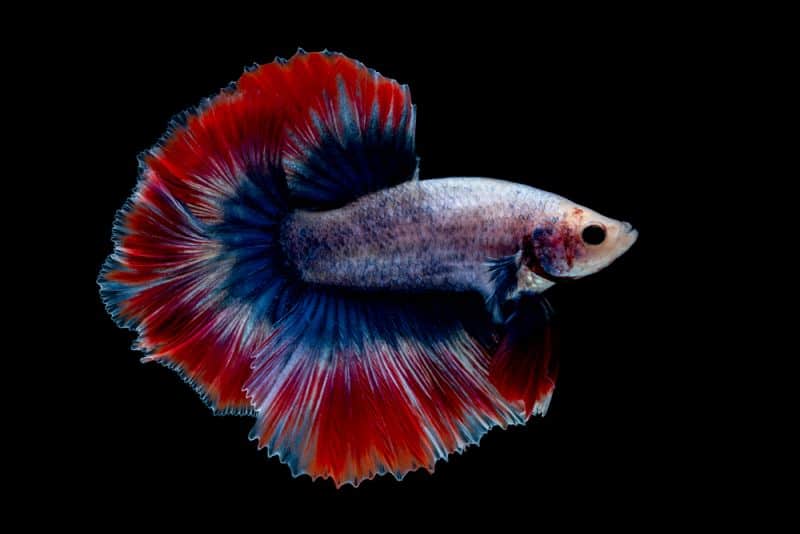Last Updated on June 23, 2022
No one’s ever said that the world of betta fish is an easy topic to talk about. You probably already know that there are many different betta varieties out there and it can be hard knowing which type you should get when picking out a new pet!
Having a lot of betta splendens varieties is one of the reasons why fish owners and betta breeders love bettas so much-they’re always coming up with new and interesting types!
In this article, we’ll talk about the rosetail betta variant in particular. So keep reading below for all your questions (and even doubts) answered regarding these beautiful little fellows.
Table of Contents
Rosetail betta fish care sheet
| Minimum Tank Size: | 5 Gallons |
| Diet: | Carnivore, Protein-rich diet |
| Average Lifespan: | 3-5 years |
| Size: | Approximately 2.5-3 inches |
| Issues: | The common ones include difficulty breathing, prone to injuries and fatigue, and tail biting |
| Decorations: | Plants and toys |
| Tank Maintenance: | Weekly partial water renewal with a water temperature of 72 to 82 Fahrenheit (22.2 – 27.8 Celcius) |
What is a rosetail betta?

The rosetail betta fish, also known as the rose petal betta or feathertail bettas, is one of the newer varieties that have been added to what has long been a popular aquarium fish. With their large flowing D-shaped caudal fin, these fish are really something to keep in your home!
Considered as a variation of the halfmoon betta, which tail fin spreads around 180 degrees when expanded, rosetail betta fish’s name comes from its intricate flowing tail fins. However, the rosetail betta was far more bred than the halfmoons to make their tails and fins past the spread of the halfmoon.
Due to this breeding, the tails of this fish resemble flowing rose petals in the water. The size of their tails was so huge that they often overlap the fins of other betta varieties.
Origins of rose petal betta fish
The origin of the rosetail or rose petal betta was first recorded in the late 1980s. To get more ideas on this betta variety here is brief information about where they came from.
Selective breeding of bettas
Most of the domesticated betta fish have been selectively bred from the short-finned Plakat bettas.
Over the years of breeding, aggressiveness, color, size, and hardiness were taken into consideration whenever betta fish breeders carefully choose genes they want to become more prominent for some betta fish.
Because of this, betta keepers have witnessed changes in the betta tail type and finnage of various betta breeds. However, the hardiness and aggressiveness of the betta splendens were maintained throughout the breeding process.
Related: How Long Does It Take For Betta Fish To Mate?
Breeding of the rosetail
Well-known breeders Rajiv Masillamoni developed the rosetail variant in 1989 although its name was not originally that until Jeff Wilson called it rosetails in 1991. Interestingly, Wilson was also the man who coined the term halfmoon.
In an attempt to perfect the halfmoon breed, rosetails were discovered as a result of mutation.
While these were interesting due to their unique traits like fins resembling rose petals, opinions about them are divided because of how fragile and weak their swimming ability is.
Issues with rosetail betta

Breeding bettas are not all rainbows and colors. Sometimes their stunning looks come with a price.
In the case of rosetails, health issues seem to outweigh their other positive traits for some hobbyists. But what is it about their health that seems to tear fish keepers apart?
Fatigue
A betta fish will often rest in a substrate, on broad-leaved plants, or even on decorations. They may even enjoy resting on hammocks (or logs) which makes them more comfortable!
Resting for betta fish is a natural behavior for most parts however it’s a different case for bettas with huge fins.
Having spectacular, flowing, and heavy tails and fins cause the rosetail fish to tire out easily when swimming around. Because of this, they tend to rest more than the other bettas which could affect their overall health.
Moreover, difficulty swimming can become more likely as your betta fish grows older.
Difficulty breathing
Betta fish are known to have a labyrinth organ that enables them to breathe on the surface of the water. This is why it is also a common behavior for them to swim and eat on the surface.
If they are weighed down by their tails and fins, your little friend will have a hard time going to the surface to breathe and eat betta food. In the worst-case scenario, your betta fish may suffocate if they don’t have the energy to reach the water surface.
Injury and infection-prone
Rosetail betta fins and tails are more likely to get caught on objects in your tank than the short-finned varieties of betta fish.
If they get injured in aquarium equipment, this will most likely result in tail or fin ripping and shredding which could lead to infection if not treated properly. Sometimes the weight of their tail could be overwhelming for them which can break their fin rays and make them crippled.
Another possible scenario is that your betta fish get a bacterial or fungal fin rot infection caused by the dragging and ripping off their finnage.
Tail biting
When some rosetail bettas attempt to rid themselves of their burdensome tail weight, they resort to biting it off. This creates a greater risk for bacterial conditions like fin rot, so owners must keep the tank super-clean should this happen!
How can you help your fish?
Although their immune system is compromised, this doesn’t mean that rosetails can’t thrive in your home. With proper care, feeding, and environment your rosetail will be able to live out its life happily.
Here are some tips to know about how you should take care of your little friend:
Tank shape
As discussed earlier, your betta fish would need to swim at the water surface from time to time. Swimming can be tough on them when they’re cramped in a small space.
One of the best ways to make your betta fish happy is by giving it a tank that comfortably accommodates its needs. A common issue with these tanks, though, is their size.
The shallower and longer the tank is, the better it is for your fish! This way, their fins will never get stuck against rocks or other objects which means that they can easily reach food without making any extra effort to swim up the surface of the tank.
Decoration
Your fish thrives in an environment where they will be stimulated. Without toys or hiding places, these little creatures will get bored easily.
Since their finnage can get easily caught in objects, you may want to choose toys or ornaments with no sharp edges.
In fact, there are many possible options to choose from. You may include caves, hammocks, floating logs, and even a ping-pong ball!
Related: 11 Best Toys for Betta Fish
Plants
Live plants are the best way to keep your rosetail betta healthy, and they also increase oxygen levels in the aquarium.
If you have no access to live plants, you may also opt for silk plants which can serve as a resting place for your betta.
Minimal flow filter
So you want to set up the perfect tank for your new betta fish, but it can be a little tricky. The key is finding just the right balance of water circulation and filtration so that there’s enough movement in order to clean out any impurities without making things too turbulent.
In the wild, bettas used to live in stagnant and slow-moving waters. Since their long fins can make swimming more challenging, adding unnecessary stress by choosing a strong filter should be avoided.
If you use an intake covering or sponge filter on top of your grates, this will ensure that all those delicate fins won’t get sucked away by giant currents!
- Dense floss removes particles and debris
- Activated carbon removes toxins, odors and discoloration
- Patented bio-holster removes toxic ammonia and nitrites
- Diffuser grid removes additional toxins while adding oxygen for more active fish
- Reduces splashing making the return exceptionally qu
Prices pulled from the Amazon Product Advertising API on:
Product prices and availability are accurate as of the date/time indicated and are subject to change. Any price and availability information displayed on [relevant Amazon Site(s), as applicable] at the time of purchase will apply to the purchase of this product.
Conclusion
Rosetail bettas are fascinating to watch, but they do require a little more care and attention than other breeds. In this blog post, the basics of caring for a rosetail betta fish as well as some potential issues you might run into if you decide to bring one home were discussed.
If you decide to care for this betta, make sure that your little friend receives the maintenance they need in order for them to prosper in their environment!

